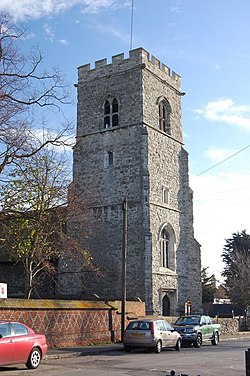Fobbing
| Fobbing | |
| Essex | |
|---|---|
 Tower of St Michael's Church | |
| Location | |
| Grid reference: | TQ715845 |
| Location: | 51°32’2"N, -0°28’27"E |
| Data | |
| Post town: | Stanford-le-Hope |
| Postcode: | SS17 |
| Local Government | |
| Council: | Thurrock |
| Parliamentary constituency: |
South Basildon & East Thurrock |
Fobbing is a small village and ancient parish in Essex. It is located between Basildon and Corringham, and is also close to Stanford-le-Hope.
History
The now quiet village is renowned for its history, which includes being one of the main villages involved with the Peasants' Revolt. On 30 May 1381, the commissioner John Bampton summoned the Fobbing villagers, as well as villagers from Corringham and Stanford, to Brentwood to answer as to why they had not paid tax. The villagers told Bampton that they would give him nothing. Bampton then moved to arrest the villagers. A riot ensued in which the villagers attempted to kill Bampton. Bampton managed to escape to London. Sir Robert Belknap was sent to investigate the incident and to punish the offenders. On 2 June, he was attacked. By this time the violent discontent had spread, and the counties of Essex and Kent were in full revolt. Soon people moved on London in an armed uprising.[1][2] In 1981 a metal sculpture by B R Coode-Adams was erected as a memorial to the Peasants' Revolt at Fobbing to commemorate the 600th anniversary.
Amenities
One of the major features of the village is St Michael's Church. It is renowned for its historic association with the smuggling trade. Once upon a time the church was near the waterfront of Fobbing Harbour. Smugglers sailed up Fobbing Creek guided by the distinctive church tower but after the great flood of 1 February 1953, the creek and harbour were sealed up by a dyke and drained. Underneath the church are many tunnels which were used by the smugglers in the 14th century.